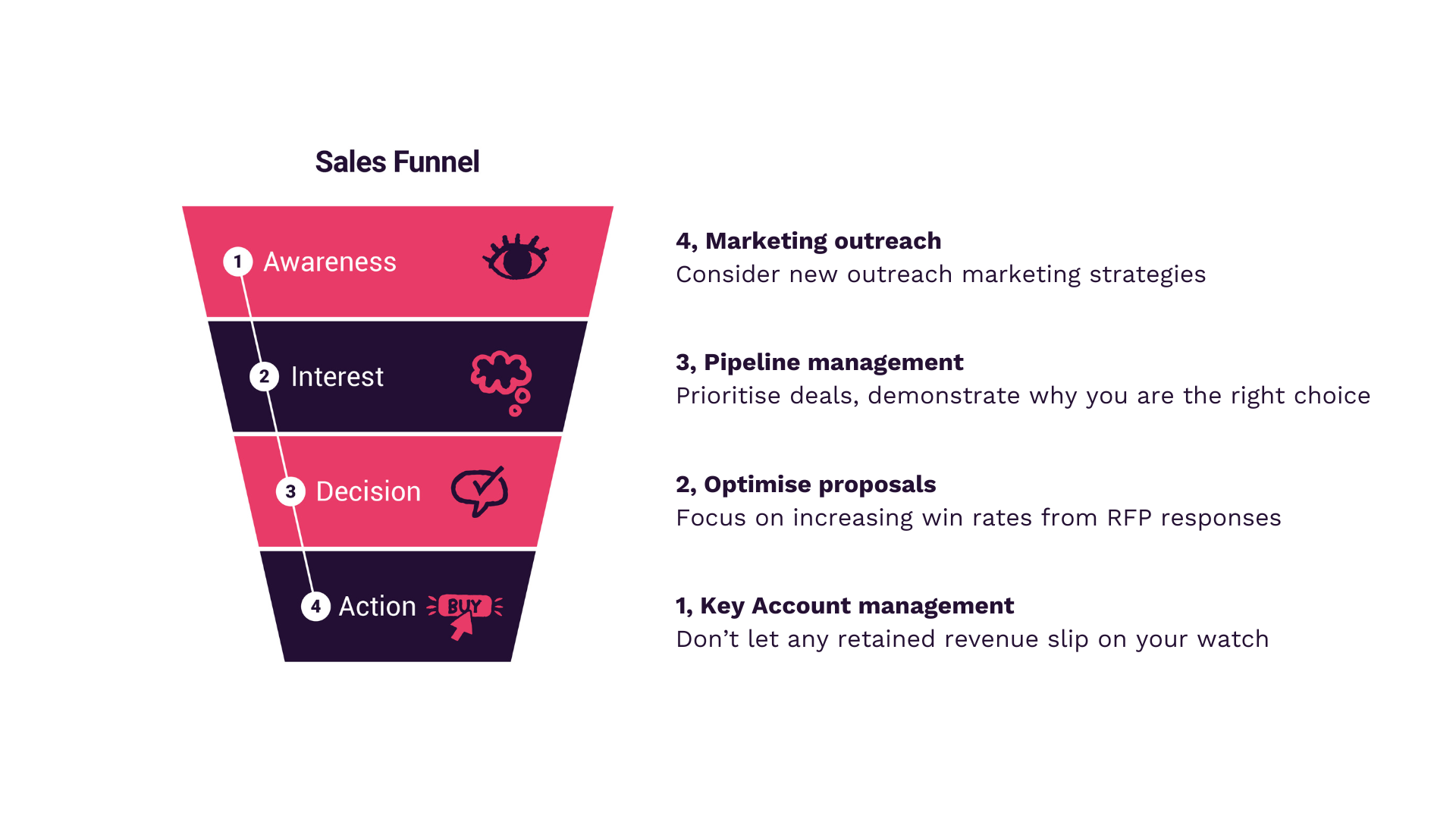
Stu Pringle
Director
Leads leads leads?
We need to improve sales. What are we going to do?
The research has been done, and the BD processes have been critically assessed. The gaps have been identified, and there may even be a SWOT or two in the report sent over.
What next?
Where to start is super important, and how change is implemented is critical to its effectiveness. The next move is not to go on a lead-gen frenzy.
More leads will solve the problem, right?
Here at Make the Break, we believe in a bottom up approach to BD. While it may seem like the focus should be on ‘getting more leads,’ we think this is this isn’t anything like the full picture. Better results come from starting at the bottom of the funnel and working backward up the stages.
Paraphrasing the excellent work of Bryony Thomas over at Watertight Thinking, you would not pour more water into a leaky bucket, and the same goes for your Business Development efforts. Adding more leads to a broken system will be inefficient, not fun, and most likely result in a conversation along the lines of…
Well… that didn’t work.
The bottom up approach to BD
Instead of spending out on lead generation activities, put time effort and budget into fixing the issues at the bottom of the funnel first. And only when you feel you’ve got that stage in a good place do you look to the next one, and then the next one and so on. And so, when the time comes to switch on the lead gen, you do so with confidence.
Ok sounds sensible, but what does all this actually mean?

While the funnel flows from the top down, the response is a bottom up approach to BD.
Key Account management
Well, why not start with people already spending with you. That’s right some good old key account management. As the old adage goes it is x times more expensive to bring in new revenue than farm existing accounts. Let’s make sure we are looking after them.
At a practical level this can mean key account hygiene including, every account having a lead name, with the team member feeling the responsibility to run regular check ins, periodic account reviews and running relevant KPIs such as asking for introductions to other teams, identifying cross-sell opportunities, up-selling, getting testimonials.
All the good things you probably know you should be doing. But are they happening?
Are you nodding along while reading this?
Optimise proposals
Next let’s make sure our proposal and closing process is working as hard as it can in our favour. If the goal is to increase sales then moving from a 25% close rate to 50%+ close rate can have a massive impact – both in the short term on current pipeline and later when there is bigger volume coming down the pipe.
Get the feedback from lost deals and speak to the team working at the sharp end. Find out the trends of why you are losing out and seek to mitigate against it in the next proposal. Pay attention to the boilerplate copy introduction – what makes you different and why choosing you is the right choice. When was this last reviewed? Has it gone stale? Is it selling the sizzle or just punting the sausage?
Find out what proof is missing. Ask yourself, do the team have the tools they need to do their jobs? Think about your case studies, testimonials, one pagers, SLA docs, technical sales sheets etc. Ask the hard questions. Are you leaving money on the table because you are not giving the prospect the info they need at the time they need it?
High performing collateral goes far beyond transactional messaging. Case studies should have clear client benefits, quantified gains and quotes from happy clients. If you are using illustrations, why rely on stock imagery or poor quality screen grabs. Instead, strive for custom illustrations and images to showcase your expertise. The same goes for team CVs if you are consultancy business putting in secondment. Make sure those team CVs are both good looking, and, when it comes to content, are all killer no filler.

Book now to give your business a health check
Our health check will shine a torch around the inside of your sales and marketing set up.
We will identify frictions and highlight what support would help.
Pipeline management
Once you are confident that key accounts are covered and proposals are doing all they can to work in your favour, now it is time put the heat on pipeline management.
All opportunities should be qualified, rated and loaded. As a team you should be making sure the basics are being done – even the very simple things such as following up as promised, on time, in the way promised on the call. If you are still managing pipeline by spreadsheet, seriously consider moving across to some basic software that allows for a Kanban view with drag and drop deal tracking. Read more on how to get this going in this blog post.
Make sure you have suitable collateral for each stage of decision that answers key questions and makes you look not like a risky choice – prove you have done it for others in the same position. Take a look at the visuals, make sure consistency is there and cut out the fluff.
And most importantly, do not be afraid to ask for the deal!
Outreach
When the previous stages have been optimised, now is the point that new outreach can be considered. Going back the taps and buckets analogy, you are at a point where you have confidence that putting more in the top has a better chance of landing and less chance of leaking.
In terms of choosing the appropriate channels, there are a questions to answer around where the audience hangs out and overlay this with speed, volume and budget considerations. We’ve previously tackled this process in more detail using the marketing bullseye framework.
One thing here is to consider the customer and prospect data you hold in your business as an asset with intrinsic value. The more first party data you hold, of the right kind of people, the more you have to work with when running out an event, webinar, whitepaper or whatever the channel of choice is.
And now we’re in the familiar place of test, measure, learn and optimise the campaigns.
Next time the pressure is on, don’t default to a leads chat. Instead, consider the bottom up approach to BD.
Good luck all!
Stu
